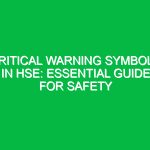Introduction
In the realm of Health, Safety, and Environment (HSE), warn symbols serve as critical visual cues designed to alert individuals to potential hazards. These symbols communicate important safety messages quickly and effectively, often transcending language barriers. Their relevance cannot be overstated; they are essential components in workplaces, public spaces, and various industries where safety is paramount. This article delves into the world of warn symbols, exploring their significance, applications, and the regulatory framework that governs their use.
Understanding Warn Symbols
Warn symbols are standardized images or graphics that convey specific safety warnings. Typically, they feature distinctive colors and shapes, making them easily recognizable. For example, a triangular shape often indicates caution, while a circular shape signifies mandatory actions. The purpose of these symbols is to provide immediate visual information that can prevent accidents, injuries, or environmental damage.
A practical example can be found in construction sites. The ubiquitous “Caution: Wet Floor” sign uses a warn symbol to indicate a slip hazard, prompting individuals to exercise caution. Such symbols are not merely decorative; they play a vital role in risk management within HSE frameworks.
Key Aspects of Warn Symbols in HSE
Categories of Warn Symbols
Warn symbols can be categorized into several types based on their intended message. Understanding these categories is crucial for effective communication in HSE contexts:
- Warning Symbols: These symbols alert individuals to potential hazards that may not be immediately obvious. For instance, a skull and crossbones denotes toxic substances, warning users of severe health risks.
- Mandatory Action Symbols: These symbols indicate actions that must be taken to ensure safety. An example is the “Wear Safety Goggles” symbol, which requires users to don appropriate protective equipment.
- Prohibition Symbols: These symbols inform individuals of actions that are not permitted in specific areas. A common example is the “No Smoking” symbol, which helps maintain safety in flammable environments.
- Emergency Information Symbols: These symbols provide essential information during emergencies, such as evacuation routes or the location of fire extinguishers.
Color Codes and Their Significance
Color plays a significant role in the effectiveness of warn symbols. Different colors convey different meanings, enhancing the symbol’s impact. Here are some key color associations:
- Red: Indicates danger or prohibition. It denotes situations that require immediate attention, such as fire hazards.
- Yellow: Represents caution. Yellow symbols alert users to potential risks that require careful consideration.
- Green: Signifies safety or the all-clear. Green symbols inform users that conditions are safe or that they can proceed.
- Blue: Indicates mandatory actions. Blue symbols communicate requirements that must be followed for safety.
Real-Life Applications of Warn Symbols
To illustrate the importance of warn symbols, consider the case of a manufacturing plant. In this environment, various hazards exist, from machinery to chemicals. The plant’s safety protocol includes comprehensive signage that employs warn symbols to communicate risks effectively. For instance, the “Hazardous Material” symbol is prominently displayed near chemical storage areas, prompting employees to wear appropriate protective gear.
In addition to preventing accidents, these symbols foster a culture of safety. Employees become accustomed to identifying hazards quickly, which ultimately leads to a safer workplace. A personal anecdote from a safety officer highlights this point: “After implementing clear warn symbols throughout our facility, we noticed a significant drop in near-miss incidents. Employees began to take ownership of their safety and that of their colleagues.”
Regulations and Standards Governing Warn Symbols
The use of warn symbols in HSE is heavily regulated to ensure consistency and effectiveness. Various international and national standards govern their design and implementation.
OSHA Standards
In the United States, the Occupational Safety and Health Administration (OSHA) provides guidelines for warn symbols in the workplace. OSHA mandates that employers must use appropriate visual communication to ensure employee safety. This includes the use of standardized warning signs that comply with ANSI Z535 standards.
ISO Standards
Globally, the International Organization for Standardization (ISO) has established guidelines for safety symbols. ISO 7010 specifies standardized safety signs to enhance recognition and understanding. This international standard helps reduce the risk of accidents by ensuring that warn symbols convey clear, consistent messages across borders.
Legal Considerations
Failing to use proper warn symbols can lead to legal implications for businesses. Inadequate signage may result in workplace accidents, leading to liability claims and regulatory penalties. Companies must stay informed about applicable regulations to mitigate risks and ensure compliance.
Benefits of Utilizing Warn Symbols
The integration of warn symbols into HSE practices offers numerous benefits:
- Enhanced Safety: Warn symbols provide immediate visual cues that can prevent accidents and injuries, creating a safer environment.
- Increased Awareness: Regular exposure to warn symbols helps employees remain vigilant about potential hazards, fostering a culture of safety.
- Legal Compliance: Utilizing standardized warn symbols helps organizations comply with regulations, reducing the risk of legal issues.
- Cost Savings: By preventing accidents, businesses can save on medical costs, insurance premiums, and potential litigation expenses.
Best Practices for Implementing Warn Symbols
To maximize the effectiveness of warn symbols, organizations should consider the following best practices:
Conduct a Hazard Assessment
Before implementing warn symbols, conduct a thorough hazard assessment to identify potential risks within the workplace. Engage employees in this process to gain insight into their experiences and concerns.
Standardize Symbol Usage
Ensure that all warn symbols used within the organization comply with recognized standards, such as OSHA or ISO. Consistency in symbol design enhances recognition and reduces confusion.
Train Employees
Provide comprehensive training to employees on the meaning and importance of warn symbols. Encourage them to report any signs of wear or damage to symbols to maintain visibility and clarity.
Regularly Review and Update Symbols
Regularly assess and update warn symbols to ensure they remain relevant to the evolving workplace environment. As new hazards emerge, adapt signage accordingly to maintain safety.
Utilize Technology
Consider leveraging technology to enhance the visibility of warn symbols. Digital displays or augmented reality applications can provide real-time hazard information, further reinforcing safety protocols.
Conclusion
In summary, warn symbols are indispensable elements of Health, Safety, and Environment practices. They communicate essential safety information effectively, enabling individuals to identify and mitigate risks swiftly. By adhering to established regulations and employing best practices, organizations can foster a culture of safety that protects employees, the environment, and the overall community.
As we continue to navigate an increasingly complex world filled with potential hazards, the importance of warn symbols will remain paramount. Organizations must prioritize their implementation and ensure that all individuals are educated about their significance. By doing so, we can create safer workplaces and communities for everyone.


